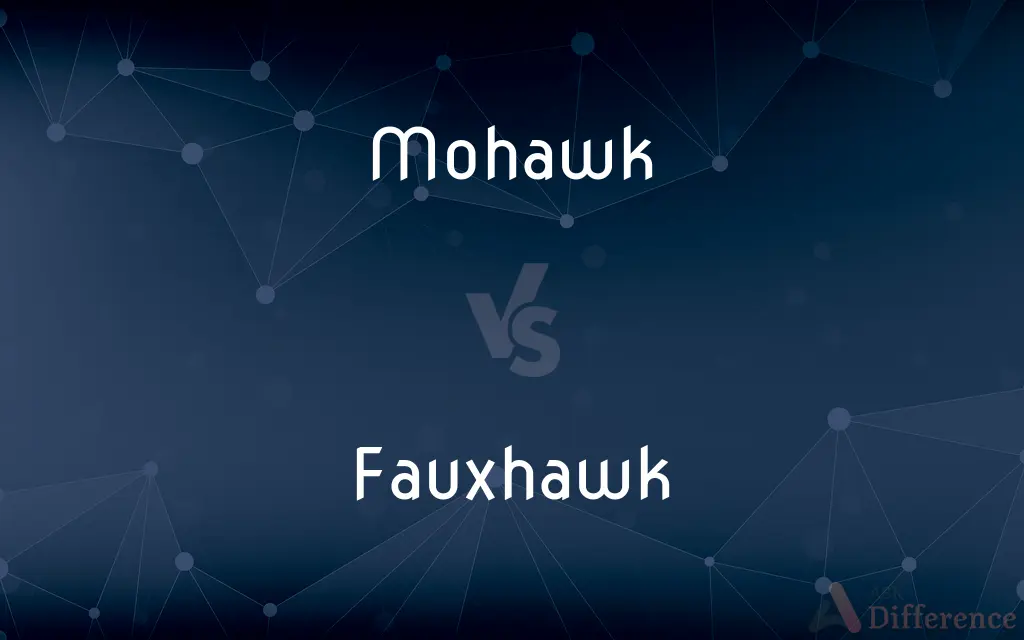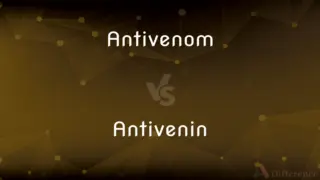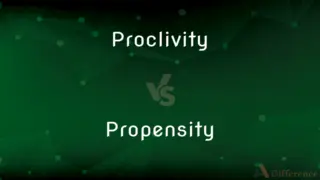Mohawk vs. Fauxhawk — What's the Difference?
By Fiza Rafique & Maham Liaqat — Updated on March 20, 2024
A Mohawk features shaved sides with a strip of long hair running from the forehead to the back of the head, while a fauxhawk mimics this style without fully shaving the sides, offering a less extreme version suitable for various settings.

Difference Between Mohawk and Fauxhawk
Table of Contents
ADVERTISEMENT
Key Differences
The Mohawk hairstyle is a bold statement, characterized by shaved sides and a pronounced strip of hair that runs from the front to the back of the head. This style has historical significance, originating from the Native American Mohawk people, and has been adopted by various subcultures, especially punk, to symbolize rebellion and individuality. In contrast, the fauxhawk (or "faux hawk") provides a versatile alternative that emulates the Mohawk's central ridge without the necessity of shaving the sides of the head. The hair on the sides is typically cut shorter than the strip in the middle but not shaved.
The Mohawk requires commitment to its distinctive look, involving shaving most of the scalp except for the central strip. Making the fauxhawk a more adaptable and reversible hairstyle. This style appeals to those who desire the edgy look of a Mohawk but need to navigate more conservative environments, such as workplaces.
While the Mohawk makes a bold statement and often requires a certain level of confidence and commitment to maintain, the fauxhawk offers a compromise, blending the distinctive Mohawk look with everyday wearability. The fauxhawk is particularly popular among individuals who wish to stand out yet prefer not to commit to the extreme nature of a traditional Mohawk.
Both hairstyles allow for personal expression and creativity, with variations in the length, color, and styling of the hair strip. However, the choice between a Mohawk and a fauxhawk often comes down to personal preference, lifestyle, and the degree of statement one wishes to make.
Comparison Chart
Sides
Shaved
Short, not shaved
ADVERTISEMENT
Middle Strip
Long and prominent
Shorter than Mohawk, can be styled to stand up
Commitment
High, due to shaving
Lower, as it allows for more flexibility
Statement
Bold and rebellious
Edgy yet adaptable
Origin
Native American Mohawk people, punk subculture
Inspired by the Mohawk, more recent adaptation
Suitability
Subcultures, personal expression
Wider range of environments, including workplaces
Maintenance
Requires upkeep of shaved sides
Easier to maintain and change
Compare with Definitions
Mohawk
Shaved sides with a central strip.
The Mohawk requires regular shaving of the sides to maintain its look.
Fauxhawk
Mimics Mohawk without shaving.
The fauxhawk is great for those who prefer not to shave the sides.
Mohawk
Symbol of rebellion.
Her Mohawk stands out in the crowd, a symbol of her individuality.
Fauxhawk
Modern, adaptable style.
His fauxhawk adds an edge to his professional attire.
Mohawk
Classic punk style.
He sports a Mohawk to match his punk band persona.
Fauxhawk
Less commitment required.
She opted for a fauxhawk to avoid the maintenance of a traditional Mohawk.
Mohawk
Variations in styling.
He dyed his Mohawk bright green for the concert.
Fauxhawk
Styling flexibility.
He styles his fauxhawk differently depending on the occasion.
Mohawk
Historical significance.
The Mohawk hairstyle reflects the warrior spirit of its Native American origins.
Fauxhawk
Suitable for various settings.
The fauxhawk works well in both casual and formal environments.
Mohawk
A member of a Native American people formerly inhabiting northeast New York along the Mohawk and upper Hudson Valleys north to the St. Lawrence River, with present-day populations chiefly in southern Ontario and extreme northern New York. The Mohawk were the easternmost member of the Iroquois confederacy.
Fauxhawk
A hairstyle in which the hair is longer or fixed in a ridge running from the forehead to the nape, and the sides of the head are not shaved.
Mohawk
The Iroquoian language of the Mohawk.
Fauxhawk
An imitation of the Mohawk hairstyle in which a central tuft is created using gel without having to shave the sides of the head.
Mohawk
A hairstyle in which the scalp is shaved except for an upright strip of hair that runs across the crown of the head from the forehead to the nape of the neck.
Mohawk
Alternative case form of Mohawk
Mohawk
One of a tribe of Indians who formed part of the Five Nations. They formerly inhabited the valley of the Mohawk River.
Mohawk
One of certain ruffians who infested the streets of London in the time of Addison, and took the name from the Mohawk Indians.
Mohawk
A member of the Iroquoian people formerly living along the Mohawk River in New York state
Mohawk
The Iroquoian language spoken by the Mohawk people
Common Curiosities
Which hairstyle is older, Mohawk or fauxhawk?
The Mohawk has historical origins and is the older style, while the fauxhawk is a more recent adaptation.
How do I maintain a Mohawk?
Maintaining a Mohawk involves regular shaving of the sides and styling of the central strip.
Can both hairstyles be colored?
Yes, both Mohawk and fauxhawk styles can be dyed in various colors for additional personal expression.
Do Mohawks have cultural significance?
Yes, the Mohawk originates from the Native American Mohawk people and carries cultural significance.
Is there an age limit for these hairstyles?
No, there's no age limit, but the choice of style often reflects personal lifestyle and aesthetic preferences.
Can a fauxhawk be converted into a Mohawk?
Yes, converting a fauxhawk into a Mohawk typically involves shaving the sides of the head.
Is the fauxhawk acceptable in professional settings?
Generally, yes. The fauxhawk is considered adaptable and can be styled to fit more conservative environments.
What are some popular variations of these styles?
Variations include the liberty spikes for Mohawks and the textured or messy look for fauxhawks.
Can women wear these hairstyles?
Absolutely, both Mohawk and fauxhawk styles are popular among women who prefer bold or edgy hairstyles.
How do people react to these hairstyles?
Reactions vary widely, from admiration for their boldness to preference for more traditional styles.
What does wearing a Mohawk signify?
Wearing a Mohawk often signifies rebellion, individuality, and association with certain subcultures.
Which hairstyle is easier to reverse?
The fauxhawk is easier to reverse since it does not involve fully shaving the sides of the head.
What should I consider before choosing one of these hairstyles?
Consider your lifestyle, work environment, and willingness to maintain the style, as well as the statement you wish to make.
Can I have a fauxhawk with long hair?
Yes, a fauxhawk can be styled with longer hair by creating a pronounced central peak while keeping the sides longer than a traditional Mohawk.
How does the fauxhawk differ in styling?
The fauxhawk is styled to mimic the look of a Mohawk but with less severe shaving, allowing for a softer appearance.
Share Your Discovery

Previous Comparison
Antivenom vs. Antivenin
Next Comparison
Proclivity vs. PropensityAuthor Spotlight
Written by
Fiza RafiqueFiza Rafique is a skilled content writer at AskDifference.com, where she meticulously refines and enhances written pieces. Drawing from her vast editorial expertise, Fiza ensures clarity, accuracy, and precision in every article. Passionate about language, she continually seeks to elevate the quality of content for readers worldwide.
Co-written by
Maham Liaqat














































